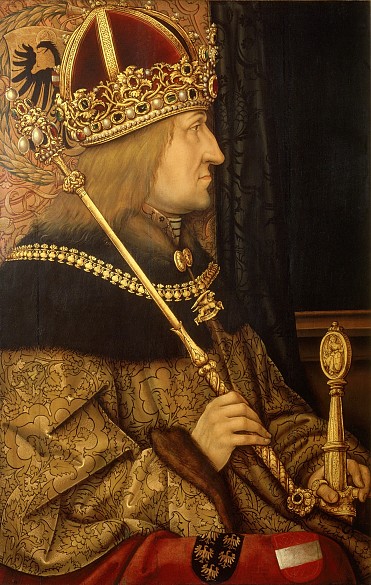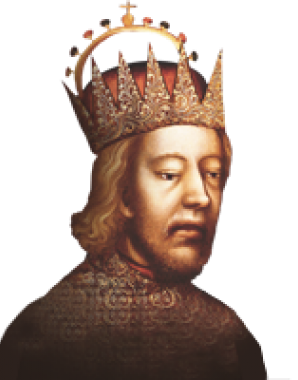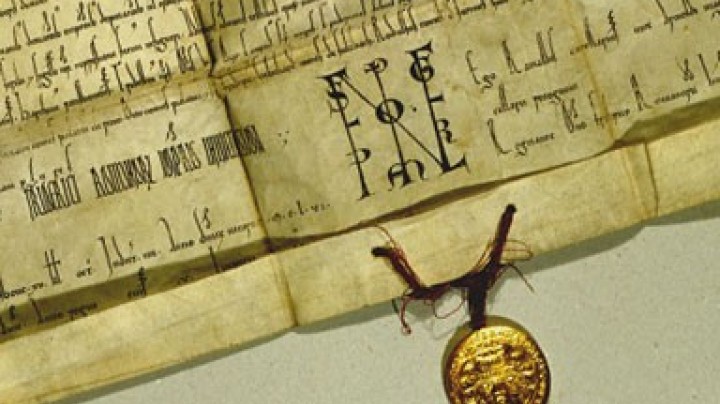Frederick V: from deepest humiliation to late triumph
Frederick was surrounded by a phalanx of adversaries, his rule challenged both within his family and by his powerful neighbours. Thanks to his tenacity he survived in the fundamental sense of the word as all his enemies died before him.
Frederick’s conflict with his younger brother Albrecht IV over their paternal inheritance culminated in 1462 in the siege of the Hofburg at Vienna, where Frederick barricaded himself in against his brother, who had successfully mobilized the Viennese citizenry against the emperor. After four months salvation appeared in the guise of a Bohemian army sent by George of Poděbrady, who had taken Frederick’s side in this intrafamilial conflict.
This problem solved itself in Frederick’s favour when Albrecht died suddenly in 1463. Thereafter his rule was to remain unchallenged within the family.
At first Frederick managed to consolidate his circumstances. He took up the project cherished by Duke Rudolf IV of having Vienna raised to the status of a bishopric, accomplishing this in 1469 and achieving the same status for Wiener Neustadt, which he preferred as his residence, never being quite sure of the loyalty of the Viennese populace. The presence of the imperial court led to a huge upswing in the smaller city’s fortunes.
As sovereign in the Austrian lands Frederick worked steadily to strengthen his position internally. Resistance from the nobility and the cities was eliminated. The final serious revolt against his authority was the so-called ‘Baumkircherfehde’ (Baumkircher Feud). A mercenary commander and former liegeman of Frederick, Andreas Baumkircher, instigated a revolt among the Styrian nobility with the support of Matthias Corvinus. With great difficulty Frederick negotiated a truce and had his adversary summarily executed in Graz in 1471, despite having issued an assurance of safe conduct.
This local revolt by the nobility was however only the signal for a more wide-ranging conflict: Matthias Corvinus began to drive Frederick out of the majority of his ancestral dominions. Buttressed by an enormous power base and huge resources, the Hungarian king now represented a serious threat to Frederick. In 1477 Corvinus succeeded in occupying Styria, Frederick’s heartland, and in 1485 he conquered Vienna. Frederick had to retreat westwards, and Linz now became his residence. In this seemingly hopeless situation Frederick was once again saved by the sudden death of his adversary: Matthias died unexpectedly in Vienna in 1490 at the age of forty-seven.
Frederick’s weakened position in his ancestral lands had an effect on his standing within the Empire: alongside the emperor, whose scope for action was severely limited, the princes of the Empire wanted to set up a more active (anti-)king who would one day assume the succession. Thanks to a series of shrewd diplomatic moves and by exploiting the disunity among the princes Frederick managed to avert this scheme and began his endeavours to install his son Maximilian as his successor.
This also constituted the backdrop to his first rapprochement with Duke Charles the Bold of Burgundy in 1463, in which Frederick attempted to put his son into play as a potential bridegroom for Charles’s daughter Mary. At first this scheme was unsuccessful as Charles made extreme demands from a position of strength – he wanted to become Roman-German King himself or at the very least to have his dukedom elevated into a kingdom. The negotiations were broken off without result.
In 1486 Maximilian finally became Roman King, while his father was still alive. As co-regent he had a difficult relationship with his father: on one side stood the young king, full of zest for action, and on the other his pragmatic father whom bitter experience had taught to exercise caution.
With characteristic tenacity Frederick managed to pull off a late success, persuading his cousin Siegmund of Tyrol, who had no legitimate offspring, to cede Tyrol to Maximilian. When Matthias Corvinus died in 1490, time had once again worked in Frederick’s favour, and Maximilian was able to establish himself as ruler in Austria. Frederick came to an arrangement with the new king of Bohemia and Hungary, Ladislaus II Jagiello, who had been accepted as ruler by the Estates of both countries. For mutual support an alliance and a contract were concluded that formed the basis for the devolving of the crowns of Bohemia and Hungary to the House of Habsburg, an event which took place in 1526.
















